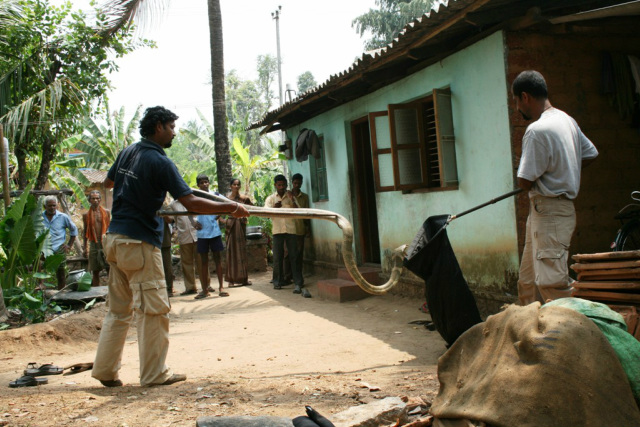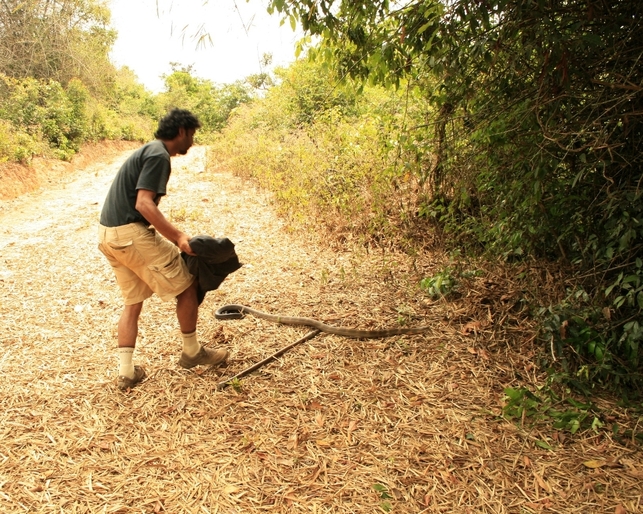 Bagging the snake_Photo by Sharmila R
Bagging the snake_Photo by Sharmila R By Sahas Barve
The King Cobra Telemetry Project initiated at the Agumbe Rainforest Research Station in Karnataka and carried out between 2008-2011, was the first radio telemetry study of snakes in India. The study took field biologists deep into the rainforests of the Western Ghats. They tracked these large serpents through pouring rain, across deep swamps and up steep mountains. Surprisingly, the snakes also led the researchers through villages and people’s backyards. This unraveled a unique co-existence, where these snakes, which eat and control populations of other venomous snakes, live in close proximity to the people who revere them as holy without much conflict. Three years of following king cobras has thrown up a wealth of new information on their movement and ranging patterns, behavior, diet and social interactions in the wild. All these data are crucial for a better understanding of king cobra ecology and invaluable for designing a conservation plan for the species. I was lucky to be a part of the king cobra telemetry project, which gave me a rare insight into the day-to-day lives of these magnificent snakes and also helped uncover the harmful effects of a commonly used snake control practice.
The King Cobra Telemetry Project initiated at the Agumbe Rainforest Research Station in Karnataka and carried out between 2008-2011, was the first radio telemetry study of snakes in India. The study took field biologists deep into the rainforests of the Western Ghats. They tracked these large serpents through pouring rain, across deep swamps and up steep mountains. Surprisingly, the snakes also led the researchers through villages and people’s backyards. This unraveled a unique co-existence, where these snakes, which eat and control populations of other venomous snakes, live in close proximity to the people who revere them as holy without much conflict. Three years of following king cobras has thrown up a wealth of new information on their movement and ranging patterns, behavior, diet and social interactions in the wild. All these data are crucial for a better understanding of king cobra ecology and invaluable for designing a conservation plan for the species. I was lucky to be a part of the king cobra telemetry project, which gave me a rare insight into the day-to-day lives of these magnificent snakes and also helped uncover the harmful effects of a commonly used snake control practice.
 King cobra release_Photo by Prashanth P (1)
King cobra release_Photo by Prashanth P (1) Results of an experiment performed during the study revealed a very important issue for snake conservation as a whole in India and highlighted the urgent need for research on common snake species. The first radio tagged king cobra was translocated and released 40km from where it was caught, into the rainforests near Agumbe. When compared to the movement patterns of non-translocated king cobras, we realized the translocated snake showed extremely erratic movement and ranging behavior. It neither showed a fixed home range like the others nor did it eat as regularly as the others. This novel finding revealed that snakes have exceptionally detailed spatial knowledge of their home ranges and translocating them to a new area far away, limits their ability to find food, escape predators and find safe resting sites. We published these findings in a recent paper (Barve et al. 2013). This and other studies from around the world are exposing the detrimental effects of translocation on individual snake survival.
Human-snake conflict is probably the most widespread human-wildlife conflict in India. Every year as many as one million snakebites are reported in India and many thousands of snakes are killed because of ignorance and habitat alterations. Over the last decade however, snake enthusiasts around the world increasingly volunteer to remove snakes from people’s houses and properties. Such snakes are often translocated many kilometers and released in the closest designated forest patches. Our study on king cobra translocation and results of other studies around the world suggest that long distance translocation is not a good practice and may lower individual survival rates of translocated snakes considerably in the their translocation sites.
Translocation is often the only option for dealing with snakes that enter people’s houses. Our study however has highlighted the importance of studying optimal distances for translocating snakes. There is a dire need for raising awareness of snakes among people and studying the fate of the snakes and the habitats in which they are translocated (Barve S 2013, Translocation tragedies: Are we really rescuing snakes?). Such research will immensely help manage the extensive human snake conflict in India.
Reference: Barve S., Bhaisare D., Giri A., Gowrishankar P., Whitaker R. and Goode M. 2013. A preliminary study on translocation of “rescued” King Cobras (Opihiophagus hannah). Hamadryad, 36 (2) 80-86.
Human-snake conflict is probably the most widespread human-wildlife conflict in India. Every year as many as one million snakebites are reported in India and many thousands of snakes are killed because of ignorance and habitat alterations. Over the last decade however, snake enthusiasts around the world increasingly volunteer to remove snakes from people’s houses and properties. Such snakes are often translocated many kilometers and released in the closest designated forest patches. Our study on king cobra translocation and results of other studies around the world suggest that long distance translocation is not a good practice and may lower individual survival rates of translocated snakes considerably in the their translocation sites.
Translocation is often the only option for dealing with snakes that enter people’s houses. Our study however has highlighted the importance of studying optimal distances for translocating snakes. There is a dire need for raising awareness of snakes among people and studying the fate of the snakes and the habitats in which they are translocated (Barve S 2013, Translocation tragedies: Are we really rescuing snakes?). Such research will immensely help manage the extensive human snake conflict in India.
Reference: Barve S., Bhaisare D., Giri A., Gowrishankar P., Whitaker R. and Goode M. 2013. A preliminary study on translocation of “rescued” King Cobras (Opihiophagus hannah). Hamadryad, 36 (2) 80-86.

Sahas is a Ph.D candidate in the Department of Ecology and Evolutionary Biology at Cornell University. He is interested in the biogeography, community ecology and evolutionary biology of avian and non-avian reptiles.
 RSS Feed
RSS Feed